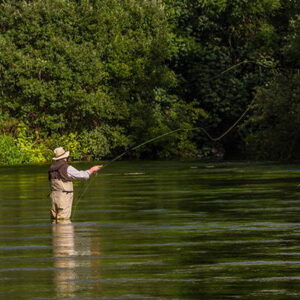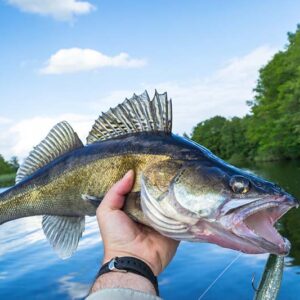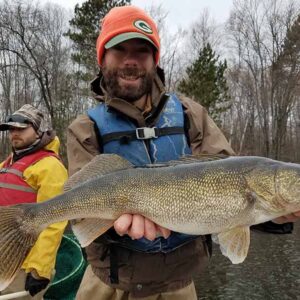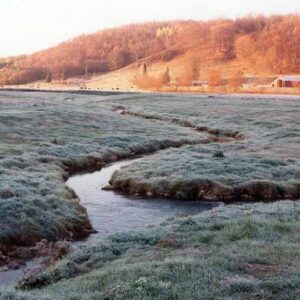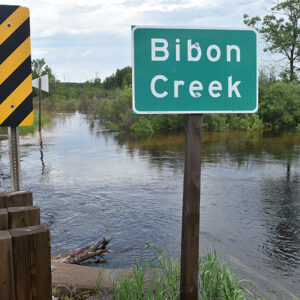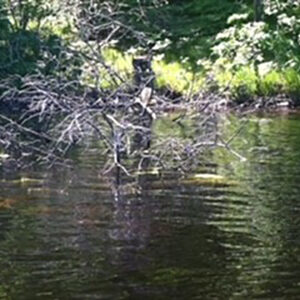WICCI’s Fisheries Working Group investigates the effects of Wisconsin’s changing climate on fish populations, aquatic communities, and fisheries.
The working group began with a focus on coldwater fisheries, working with downscaled climate projections for Wisconsin provided by the Climate Working Group. We used models and observational data to predict current and project future distributions of Brook Trout and Brown Trout in streams across the state.
We have broadened the scope of our working group to include coolwater and warmwater fishes, which are also expected to be impacted by changes in Wisconsin’s climate, and our work will address both direct and indirect effects of climate change on fishes and aquatic communities.
Summary of Issues and Impacts
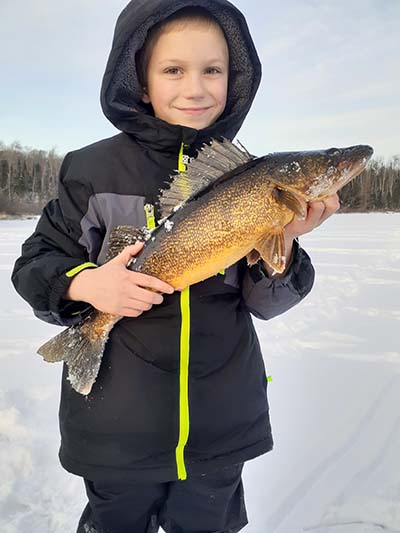
Fishing is an important part of the culture and economy in Wisconsin. Coldwater streams, including over 13,000 miles in 2,989 classified trout streams, represent an economically important recreational fishery for the state. As water temperatures warm, the fish species that can live in our waters will change.
More frequent extreme storms and heat events that are already happening as the climate warms are damaging fish habitat and stressing fisheries. These impacts will intensify as the climate continues to warm.
Wisconsin’s cool and coldwater fish assemblages, including some of the most popular and sought-after fish, are particularly at risk. These species include lake whitefish, lake trout, cisco, walleye, muskellunge, and yellow perch. Without action, habitat loss combined with overfishing and expansion of invasive species and warmwater competitors may devastate local coolwater fish populations.
Warming waters mean shifting fish communities and fishing experiences for anglers, Ojibwe subsistence fishers, commercial fishers, and others who benefit from the economic, ecological, cultural resources fishes provide.
Reduced Cool and Coldwater Fish Habitat
Increasing temperatures will reduce habitat availability for iconic cool and coldwater fish, like brook trout, cisco, lake trout, and walleye.
Expanded Warmwater Fish Ranges
Range expansions of warmwater fish, like bass and sunfish, due to warming lakes and streams will cause imbalances in fish communities favoring warmwater species.
Reduced Spawning and Refuge Habitat
Lower lake levels due to droughts will reduce spawning and refuge habitat for some fish species.
Increased Frequency of Fish Kills
Extreme heat events will increase the frequency of fish kills that may have negative long-term consequences for fish populations.
Changing Ice Fishing and Spawning Conditions
Shorter, warmer winters and increasingly unpredictable spring and fall conditions will limit ice fishing opportunities, change the timing of fish spawning and reduce the survival of newly hatched fish.
Degrading Nearshore Habitats
An increasing frequency of extreme weather events will degrade important riparian and nearshore habitats.
Increased Impacts from Invasive Species
Warming waters will increase the potential for expansion of invasive species and exacerbate the negative effects of current invasive species.
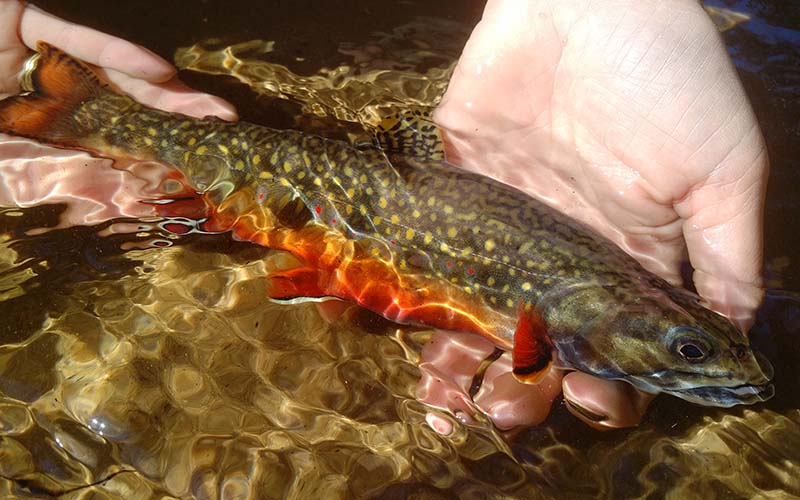
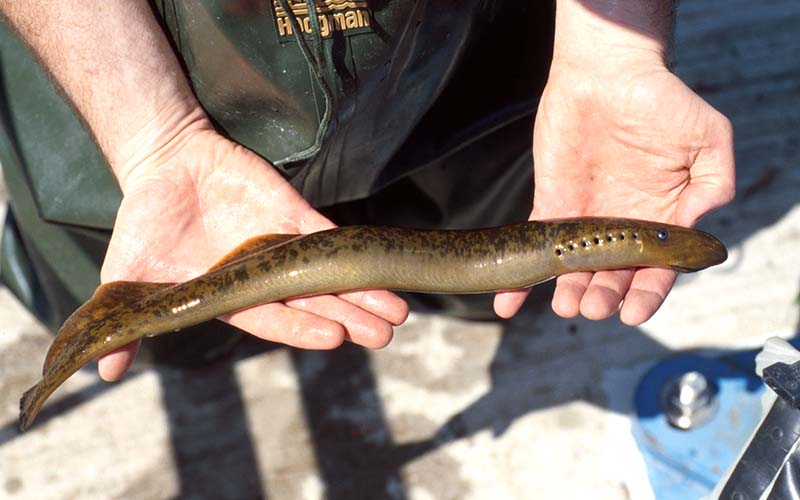
Recommended Solutions/Strategies
1
Identify and preserve stronghold populations of vulnerable cold and coolwater fish in streams by increasing protections of critical streams and watersheds for native fish and developing habitat (making stream channels narrow and deep, reducing streambank erosion, reconnecting streams to floodplains and wetlands, providing strategic shading).
2
Manage fisheries to prevent overharvest and protect productive populations of fish in lakes by identifying and protecting sentinel lakes with resilient cool and coldwater fish, riparian buffers, and land management to reduce runoff.
3
Prevent expansion of native warmwater and invasive species via outreach and education, best management practices, and expanded invasive species monitoring.
4
Protect commercially and recreationally important Great Lakes fisheries, such as yellow perch and whitefish, through harvest control rules and protection of spawning and nursery habitats.
Environmental and Climate Justice Issues
The Fisheries Working Group identified the primary environmental and climate justice concerns are the effects of climate change on subsistence and cultural fishing rights. The working group specifically calls for decision makers to consider the impacts of climate change on subsistence fishing in Wisconsin by groups such as Wisconsin’s Hmong population and First Nations tribal fisheries in the Ceded Territory.
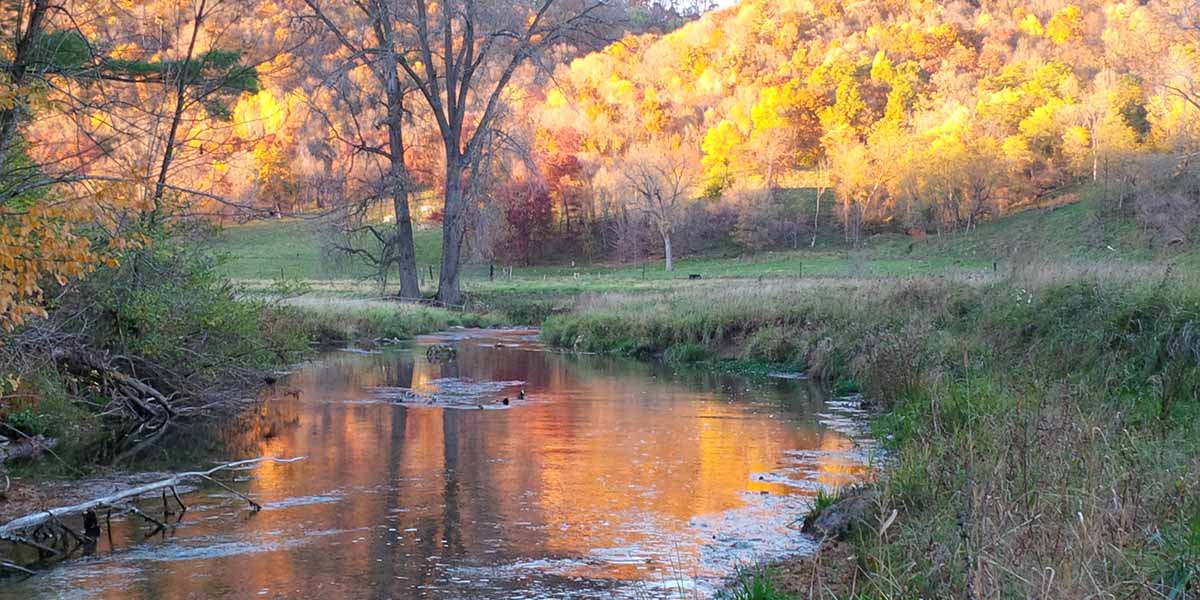
Resources
This is an accordion element with a series of buttons that open and close related content panels.
Academic Papers
Tingley III et al. 2019. Adapting to climate change: guidance of the management of inland glacial lake fisheries.
Collingsworth et al. 2017. Climate change as a long-term stressor for the fisheries of the Laurentian Great Lakes of North America.
Carpenter et al. 2017. Defining a safe operating space for inland recreational fisheries.
Gaeta et al. 2014. Drought-driven lake level decline: effects on coarse woody habitat and fishes.
Rypel et al. Eroding productivity of walleye populations in northern Wisconsin lakes.
Hansen et al. 2015. Largemouth bass management in Wisconsin: intraspecific and interspecific implications of abundance increases.
Pedersen et al. 2017. Long-term growth trends in northern Wisconsin walleye populations under changing biotic and abiotic conditions.
Embke et al. Production dynamics reveal hidden overharvest of inland recreational fisheries.
Mitro et al. 2019. Projected changes in brook trout and brown trout distribution in Wisconsin streams in the mid-twenty-first century in response to climate change.
Magee et al. 2019. Scientific advances and adaptation strategies for Wisconsin lakes facing climate change.
Renik et al. 2020. Status and distribution of cisco (Coregonus artedi) and lake whitefish (Coregonus clupeaformis) in inland lakes of Wisconsin.
Hansen et al. 2017. Projected shifts in fish species dominance in Wisconsin lakes under climate change.
Sharma et al. 2011. Comparing climate change and species invasions as drivers of coldwater fish population extirpations.
Lyons et al. 2015. Trends in the reproductive phenology of two Great Lakes fishes.
Newspaper Articles, Blog Posts, and Videos
Coldwater Fishes
Flowing Free – Recovering Native Trout and Restoring Communities in Wisconsin. Trout Unlimited YouTube channel.
Hinterthuer, A. 10 May, 2022. Scales tipping against walleye; time to get hooked on new fish. UW-Madison News.
Keller, B. 11 May, 2022. Wisconsin walleye threatened by warming waters. WKOW TV.
Wegehaupt, N. 11 May, 2022. Report shows declining walleye population in Wisconsin. WORT radio.
Lyons 2020. Brown Trout, in Wisconsin Trout.
Lyons 2021. Brook Trout, in Wisconsin Trout.
Lyons 2020. Driftless Area Trout, in Wisconsin Trout.
Lyons 2021. Rainbow Trout, in Wisconsin Trout.
Carlson, D. 2 Apr 2015. Are lakes running out of whitefish, ciscoes? Outdoor News.
Adams, B. 11 Oct 2015. On Wisconsin: Green Lake trying to set an example. Wisconsin State Journal (subscription required).
Anderson, TW. 29 May 2014. Watching cisco for clues to fishery health. Associated Press.
Durkin, P. 11 Aug 2016. Lake trout have become trophy fish in North Woods. Wisconsin State Journal (subscription required).
Meyer, B. 9 Apr 2020. A shifting Wisconsin: Local extinctions, migrations, and culture in the face of climate change. WXPR radio.
Meyer, B. 16 Jan 2020. Northwoods lakes without winter ice? Full-lake study peers into potential future. WXPR radio.
Meyer, B. 2 Apr 2020. A ‘complete surprise’: New research shows higher lake levels equal more mercury in fish. WXPR radio.
Great Lakes
Matheny, K. 4 Apr 2015. Smeltdown: Small fish continues Great Lakes vanishing act. Detroit Free Press.
Matheny, K. 11 Feb 2020. Climate change transforming where fish in the Great Lakes can live. Detroit Free Press.
Fish Kills
Novak, B. 5 Jul 2017. Indian Lake fish kill could number in the thousands, official says. Wisconsin State Journal (subscription required).
Watson, A. 10 Jul 2019. Study: Wisconsin fish die-offs expected to rise, largely due to climate changes. Wisconsin Public Radio.
Warmwater Species Expansions
Smith, PA. 2018. Can the walleye population rebound in McDermott Lake if bass and panfish are reduced? Milwaukee Journal Sentinel.
Podcasts and Seminars
Mitro, M. 2019. What happens when the fish just can’t live here – Off the Record Podcast. Wisconsin DNR.
Seminar: Parks et al. Understanding Cisco Decline in Wisconsin’s Inland Lakes.
Recorded seminar: Dugan, H. 2020. Phenological whiplash in lakes. Northeast Climate Adaptation Center Seminar Series.
Recorded seminar: Sass, GG, and ZS Feiner. 2021. Phenological whiplash and fisheries. Wisconsin Water Week.
Climate Wisconsin story on ice fishing
Climate Wisconsin story on ice cover
Wisconsin Department of Natural Resources Spring Fyke Netting 2016 video
Management Tools
Our Team
Stakeholders and Partners
- University of Wisconsin
- Wisconsin Department of Natural Resources
- Great Lakes Indian Fish and Wildlife Commission
- Trout Unlimited
- Center for Climatic Research, Nelson Institute for Environmental Studies, UW-Madison
Members
- Zach Feiner (co-chair), Research Scientist, Wisconsin Department of Natural Resources, Zachary.Feiner@wisconsin.gov
- Alex Latzka (co-chair), Systems Biologist, Wisconsin Department of Natural Resources, Alexander.Latzka@wisconsin.gov
- Matthew Mitro, Research Scientist, Wisconsin Department of Natural Resources
- Greg Sass, Research Program Supervisor, Wisconsin Department of Natural Resources
- Stephanie Shaw, Research Scientist, Wisconsin Department of Natural Resources
- Iyob Tsehaye, Research Scientist, Wisconsin Department of Natural Resources
- Holly Embke, Research Scientist, United States Geological Survey Midwest Climate Adaptation Science Center
- Jared Homola, Research Scientist and Assistant Unit Leader, United States Geological Survey
- Dan Isermann, Research Scientist and Unit Leader, United States Geological Survey
- Aaron Shultz, Climate Change Inland Fisheries Biologist, Great Lakes Indian Fish & Wildlife Commission
- Colin Dassow, Research Scientist, Wisconsin Department of Natural Resources

